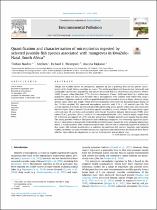| dc.description.abstract | Though the number studies on microplastic ingestion by fish is growing, data on fish species charac-
teristic of the South African coastline are scarce. This study quantified and characterised (physically and
chemically) microplastics ingested by four species of juvenile fish (viz. Oreochromis mossambicus [Peters,
1852], Terapon jarbua [Forsskål, 1775], Ambassis dussumieri [Cuvier, 1828] and Mugil sp.), within four
mangroves along the east coast of South Africa. Microplastics were isolated from whole fish using a
proteinase K digestion method, and then quantified and characterised in terms of shape, chemical nature
(plastic type), colour and length. Fibres (68%) and fragments (21%) were the dominant shapes found. Of
the 174 fish sampled, 52% contained microplastic particles, with 0.79 ± 1.00 particles per fish. The
average number of particles per fish did not differ significantly across species within sites and across sites
but was higher than in juvenile fish of other species sampled in oceanic habitats. The main plastic types
collected using 10 mm filters and identified with Fourier Transform Infrared Spectroscopy (FTIR), were
rayon (70.4%), polyester (10.4%), nylon (5.2%) and polyvinylchloride (3.0%). Particle length ranged from
0.1 to 4.8 mm, averaging 0.89 ± 0.77 mm, but irrespective of length, particles were mostly blue in colour.
This study provides evidence that juvenile fish inhabiting mangroves are consuming significant quan-
tities of microplastics. Importantly, it should be noted that rayon, though the most abundant plastic type
found, is a semi-synthetic fibre made from regenerated cellulose that is commonly reported in studies of
this nature. The habitats studied serve as nurseries for numerous fish species; however, more detailed
studies are needed to assess whether microplastic ingestion could compromise the health of these fish or
whether these effects are dependent on species, feeding habit and/or plastic type. | en_US |

